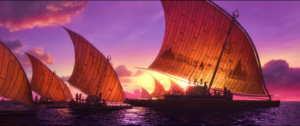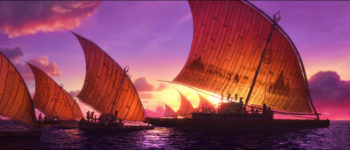700: Hui Te Rangiora
June 13, 2021
By AHNZ

Polynesian myth tells us that the demigod Maui created New Zealand (and other islands) as a product of his godly fishing expeditions. Kupe the Navigator is credited with discovering our islands for the Polynesians and leading them to migrate. According to Porirua Museum Director Reuben Friend the Museum of New Zealand has the authentic and restored anchor stone of Kupe’s canoe. In-between these two mythical figures we have one Hui Te Rangiora, the man said to have discovered New Zealand. The myth comes with a date attached, 700AD.
 “But we must not take too much notice of these dates they are reckoned by counting back the number of generations up to each period in question, (and a doubtful number of years—25— is allowed for each generation.” according to the North Canterbury Gazette (1932.) The published stories about Hui Te Rangiora attribute him extraordinary achievements and date from the mid-1920s.
“But we must not take too much notice of these dates they are reckoned by counting back the number of generations up to each period in question, (and a doubtful number of years—25— is allowed for each generation.” according to the North Canterbury Gazette (1932.) The published stories about Hui Te Rangiora attribute him extraordinary achievements and date from the mid-1920s.
These stories excited a young John Beaglehole who included an account from Percy Smith in his own histories. In his state-published book, The Discovery of New Zealand (1939) he adapted a passage that academics have been dining out on for years…
“It may have been about our year 750 that the astonishing Hui-Te-Rangiora, in his canoe Te Iwi-o-Atea, sailed from Rarotonga on a voyage of wonders in that direction (South): he saw the bare white rocks that towered into the sky from out the monstrous seas, the long tresses of the woman that dwelt there in, which waved about under the waters and on their surface, the frozen sea covered with pia or arrowroot, the deceitful animal that dived to great depths – ‘a foggy, misty dark place not shone on by the sun’. Icebergs, the fifty foot long leaves of bull kelp, the walrus or sea-elephant, the snowy ice fields of a clime very different from Hui-Te-Rangiora’s own warm islands – all these he had seen” – The Discovery of New Zealand (1939)
Turi McFarlane, in 2008, wrote a post-graduate thesis for credits in Antarctic Studies that padded out what Beaglehole had written. He took a race-based view of Antarctic exploration, singling out acts of participation in the subcontinent according to who was or wasn’t related to Maori ancestry. This is the same confounded thing Feminists to but with reference to people without Y chromosomes. Maori and Feminist geology are not unknown to the University of Canterbury Geology department nor their Antarctic Studies program.
Then came Dr Priscilla Wehi who showed that McFarlane was a mere amateur when it came to spinning gold out of Beaglehole’s passage. For a start, she dug deeper than McFarlane to find out that Beaglehole in 1939 was paraphrasing Percy Smith from 1899…
“The desire of the ariki Te Aru-tanga-nuku and all his people on the completion of the canoe, was to behold all the wonderful things seen by those of the vessel Te Ivi-o-Atea in former times. These were those wonderful things:—the rocks that grow out of the sea, in the space beyond Rapa; the monstrous seas; the female that dwells in those mountainous waves, whose tresses wave about in the waters and on the surface of the sea; and the frozen sea of pia, with the deceitful animal of that sea who dives to great depths—a foggy, misty, and dark place not seen by the sun. Other things are like rocks, whose summits pierce the skies, they are completely bare and without any vegetation on them.” The above is as literal a translation as I can make, and the meaning is quite clear; that the bare rocks that grow out of the frozen sea are the icebergs of the Antarctic.” – Smith (1899)

(It’s funny how a Victorian white man’s observations are gold when it suits the narrative but racism and colonialism incarnate the rest of the time!)
Smith’s older passage is clearly the one Beaglehole and McFarlane ran with, or, some might say, plagiarised. Smith says these visions were beheld first of Hui Te Rangiora (image left) and then, 250 years later, by another explorer named Te Aru-tanga-nuku. This c.950AD explorer is not mentioned by Beaglehole, McFarlane, or Wehi et al.
For the very most part, Wehi (2021) simply repeats and embellishes what McFarlane had already written but without any thanks or barely mentioning his name. This is odd since Wehi was part of a team of seven, backed by Manaaki Whenua Landcare Research and Te Rūnanga o Ngāi Tahu. With little more output than McFarlane’s own thesis this better-funded team could be expected to have been far more productive. Especially given the media attention…
“Polynesians first to discover Antarctica, not news to Māori”

Now came some incredible vanity for minimal academic achievements and and a will to spin myth into history…
“A study by New Zealand researchers found that Polynesians may have been the first to discover the Earth’s southernmost continent, Antarctica,..” – NZ Herald
Found? Really? Seven people repeated the ‘finding’ of McFarlane (2008) who ‘found’ an old Beaglehole book in the Macmillan Brown Library based on the ‘find’ of an old 1899 copy of the The Journal of the Polynesian Society. Nobody has added to anything Percy Smith laid down. But…that’s headline news apparently.
“But it comes as no shock to some iwi as this had always been known..”
Smith’s source did not come from Maoris. The only way they would have “always known” is by hearing it from him or one of his imitators.
“”We didn’t discover this, it’s a known narrative,” lead researcher Dr Priscilla Wehi told the Herald.”
It’s shameful how Wehi throws the authors that came before her, whose work she is ripping, under the bus in order give false credit to imaginary oral traditions.
“Now the new paper can reveal a southern voyage was conducted by Polynesian chief Hui Te Rangiora and his crew over a thousand years before the Russian expedition, “
Now? The only thing being revealed now is the dusting off of a 120 year old journal article for the umpteenth time.
“Dr Billy van Uitregt said oral tradition brought “richness to the conversation”.”
Pretending the team has been penetrating deep Amazonian rainforest to consult Polynesian shamen in high Shangri-La to discover the secrets of oral….give me a break! Why don’t they just admit they Googled this information?
“”It highlights the limitations of the written narratives that we have. that I don’t think can be captured in written word…I’d probably argue that [translating oral tradition into academic literature] isn’t a good thing.”” – Polynesians first to discover Antarctica, not news to Māori, NZ Herald (June 2021)
You know you’re dealing with a modern academic when they would “probably argue” something rather than just get on with it. And you know it’s a pontificating, duplicitous, academic when everything of substance they’ve gathered comes from written narratives but they don’t thank the sources they’re cut’n pasting but actually disparage writing itself! The huberis!
“There are growing hopes for incorporating Māori perspectives to add depth to New Zealand’s research programmes and the protection and management of Antarctica.”
Translation: The team of seven would like to be able to leverage Smith’s 1899 passage into power and funding and a say in what happens in Antarctica. It may be that the Treaty of Waitangi promises that Scott Base be handed back to Maori actually, in a future version of their report.
“She says further research will reveal more concrete evidence which will become publicly known as tribal researchers and iwi work together to share the narratives. ” – Newshub
“Wehi hopes to be able to pin down a date for the first sightings of Antarctica, with the help of iwi, who may hold more stories.” – RNZ
Fund me to find more evidence, she says. Maybe I’ll pull a rabbit out of the hat that wasn’t put there by Percy Smith? Unlikely.
British Australian and New Zealand Antarctic Research Expedition
From 1929 to 1930, New Zealand was excited about Antarctica. We were part of the British Australian and New Zealand Antarctic Research Expedition. This was primarily propagandist, for king and country, and to avenge Shackleton’s death in 1922 by taking the initiative back from the cold continent. Clustered around these years and this theme, Percy Smith’s tale of Hui Te Rangiora hit the headlines again…
“Hui-te-Rangiora was also an expert seafarer. He built himself a huge canoe; but the felling of a sacred tree to complete it caused war with’ the tribe who owned it, and his departure was not regretted.” – Speech by A Neolithic Sailor, speech by R.E Fortune; Evening Post (1925); Papers Past
“The writer of the following article here tells for the first time the English version of a Maori incantation handed down by the tohungas for untold generations. In its original form it is known today only to a select few…”
“This voyage is said to have been made many hundreds of years before the migration of the Maori to Tahiti and Rarotonga, from where, in the fourteenth century, commenced their migration to Now Zealand….Hui-te-Rangiora’s fleet consisted of five canoes. His own, “Tuahiwi-o-Atea,” was specially designed and is said to have had a keel made from human bones.” – A Maori Voyage into the Antarctic, Oliver Tahupotiki Haddon, Hawera Star (1929); Papers Past
All of this, in my opinion, was, as always, a repetition of what had been read in Percy Smith. Even Oliver Haddon, a Maori claiming to be revealing ancient secrets for the first time, showed clear embellishments of Smith. Both men speak of a tusked animal, a walrus, and both are seemingly ignorant that its habitat does not include the Antarctic. It’s the sort of story someone would tell who wanted to be important during a time there were ready ears for stories of Antarctic discovery. The sort of facts someone would consider plausible to invent who did not really know what Antarctica was like.
Hui Te Rangiora on his boat of human bones didn’t really find Tahiti, New Zealand, Antarctica, Society Islands, Rapa Island, Hawaii, and the walrus. No more than Maui captured the sun in ropes made of flax and forced it to slow down to give us longer days. Like Kupe, he’s a mythical figure not an historical one. Once we accept that we can properly appreciate him.
—
Image ref. Hui Te Rangiora carving at Te Awhina marae, Motueka; Event Finda
Ref. Maori Associations with the Antarctic, McFarlane (2008); Canterbury University
Ref. HAWAIKI: THE WHENCE OF THE MAORI: BEING AN INTRODUCTION TO RAROTONGA HISTORY, Percy Smith, The Journal of the Polynesian Society (1899); Auckland University
Ref. Lost and Found. Notes by a Pakeha Maori, North Canterbury Gazette (1932); Papers Past
 Like Comment Share
Like Comment Share





